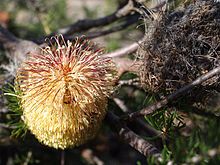
Back بنكسية خشنة الأوبار Arabic Banksia scabrella Azerbaijani Banksia scabrella CEB Banksia scabrella French Banksia scabrella Italian Banksia scabrella Portuguese Banksia scabrella Swedish Banksia scabrella Vietnamese Banksia scabrella WAR
| Burma Road banksia | |
|---|---|

| |
| Scientific classification | |
| Kingdom: | Plantae |
| Clade: | Tracheophytes |
| Clade: | Angiosperms |
| Clade: | Eudicots |
| Order: | Proteales |
| Family: | Proteaceae |
| Genus: | Banksia |
| Subgenus: | Banksia subg. Banksia |
| Section: | Banksia sect. Oncostylis |
| Series: | Banksia ser. Abietinae |
| Species: | B. scabrella
|
| Binomial name | |
| Banksia scabrella | |
Banksia scabrella, commonly known as the Burma Road banksia, is a species of woody shrub in the genus Banksia. It is classified in the series Abietinae, a group of several species of shrubs with small round or oval inflorescences. It occurs in a number of isolated populations south of Geraldton, Western Australia, with the largest population being south and east of Mount Adams. Found on sandy soils in heathland or shrubland, it grows to 2 m (7 ft) high and 3 m (10 ft) across with fine needle-like leaves. Appearing in spring and summer, the inflorescences are round to oval in shape and tan to cream with purple styles. Banksia scabrella is killed by fire and regenerates by seed.
Originally collected in 1966, B. scabrella was one of several species previously considered to be forms of Banksia sphaerocarpa, before it was finally described by banksia expert Alex George in his 1981 revision of the genus. Like many members of the Abietinae, it is rarely seen in cultivation; however, it has been described as having horticultural potential.
© MMXXIII Rich X Search. We shall prevail. All rights reserved. Rich X Search